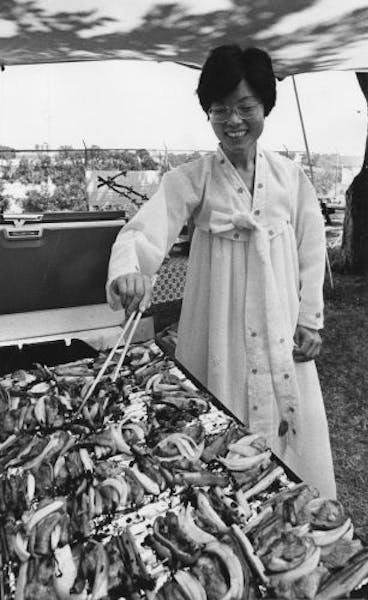Woodstock. Apollo mission to the moon. "Sesame Street" debut.
Yes, it all happened in 1969.
But what comes to my mind when I think of that year is something much more personal: the launch of Taste in the Minneapolis Star.
Taste was one of the nation's early stand-alone food sections. Food articles had appeared sporadically in papers as far back as the 1890s. But to gather all the food information in one place in a newspaper? That was new and bold and exciting.
In fact, the editors of the Minneapolis Star weren't sure a food section would have a future -- this was the paper's first experiment with a weekly section -- so they hedged their bets and gave it a name ambiguous enough that it could be used for multiple purposes. If Taste failed as a food section, then Taste the fashion section or Taste the home furnishings section could seamlessly take its place.
Needless to say, its initial application stuck, much to the relief of Beverly Kees, its first editor, who learned to cook on the job as she put out the section with two part-time journalists who had college degrees in home economics. An immediate success, with loads of grocery ads, Taste's largest issue was shortly before Thanksgiving 1971, with 44 pages that included 138 recipes and 38 articles. Those were the days.
Forty years later, the now-frayed issues of Taste are a window into the eating habits and interests of Minnesotans and other Americans. From woks to slow cookers and sun-dried tomatoes to brie and baby carrots, Taste has recorded the evolving interests in food.
Meat boycotts? Taste offered nonmeat recipes. Low-carb diets or cholesterol concerns? We were on it like pastrami on rye. Recessions? Taste offered budget recipes and advice during the inflation and oil shock downturns of the 1970s, the sharp industrial decline of the '80s, the tech bubble of 2000, and the more recent real estate collapse. Without a doubt, Taste has been timely.
As we sifted through the Taste pages, we could see how different times were. It wasn't just the bell-bottoms we wore (although women were not allowed to wear pants in the Star's newsroom then), or the fact that many women were referred to by their husband's name. (In a 1969 article about Mrs. Einar Larson, for example, we never learn her first name.)
It was a different era because we got our vegetables out of a can or the freezer. We used MSG liberally (sometimes by its trade name of Accent) and had a heavy hand with salt. Vegetarian generally meant brown rice and sprouts -- available at the food co-op, not the supermarket. Greens tended to be iceberg; cheese was likely to be Velveeta or American.
Mushrooms came out of a can, as did most soups. Public schools were just starting to include boys in the cooking classes they offered. We were impressed by exotic recipes such as Chicken Almond Ding. And we rarely ate out at restaurants.
We were thinner then, and not afraid of raw eggs or E. coli 0157:H7. In fact, there wasn't a lot of concern about food safety.
Nor did we pay much attention to the seasons when it came to food -- we didn't have to with all that canned food available.
As Rick Nelson and I paged through 40-year-old recipes, it was with the amusement and sentiment usually reserved for old yearbooks and family photos. ("What were they thinking?" was the only response to a tailgate recipe with canned lima beans and pears.)
And all that cream and butter? Fried in how much oil or lard?
Yet as we went through the archives, more than 12,000 dusty pages, we saw that Taste was ahead of the crowd from the beginning. The section was never a collection of hot dish recipes. That first year brought recipes for sangria, spritzers and buttered rum. The second issue of Taste had a Julia Child column on lobster.
In fact, Taste's 1972 cookbook included recipes for snails, frog legs, crab meat au gratin, tacos, tempura, red clam sauce. There's a recipe for Mama Rosa rigatoni that starts with one pig tail or two pig knuckles.
By 1974, there were directions for focaccia (under the name Italian Flat Bread), moussaka, polenta, boeuf Bourguignon, an African peanut stew and a vegetable salad with sweetbreads.
But hot dishes? They were few and far between, never mind what readers remember.
(History lesson: Don't confuse Taste with the Minneapolis Tribune Food section, which appeared in the "other" newspaper, often under the byline of Mary Hart, and which started in the late '70s. It later was folded into the Taste section when the two newspapers merged.)
So grab your cup of coffee and join us in our stroll through the decades. We'll continue looking at the past each week in October, and throughout the year we will post recipes from the early years. History never tasted better.
Check our blog for more glimpses of the past: startribune.com/tabletalk.
And thank you for the support -- and recipes -- that you have shared over the years. You were the ones who kept the section going.
Lee Svitak Dean, editor since 1994, has written for Taste for 30 years.
Live video of man who set himself on fire outside court proves challenging for news organizations
4/20 grew from humble roots to marijuana's high holiday

